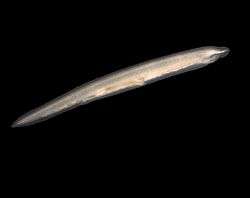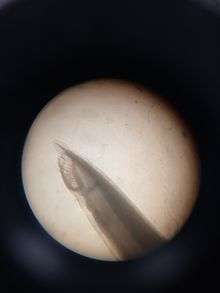Cephalochordate
| Cephalochordates | |
|---|---|
 | |
| A Branchiostoma lanceolatum lancelet | |
| Scientific classification | |
| Kingdom: | Animalia |
| Phylum: | Chordata |
| Subphylum: | Cephalochordata Haeckel, 1866[1] |
| Groups | |
| |
| Synonyms | |
| |
A cephalochordate (from Greek: κεφαλή kephalé, "head" and χορδή khordé, "chord") is an animal in the chordate subphylum, Cephalochordata. They are chordates with all 5 synapomorphies the characteristics all chordates have during the larval or adulthood stages. These synapomorphies include: notochord, dorsal hollow nerve cord, endostyle, pharynx and post-anal tail. Cephalochordates are represented in modern oceans by the Amphioxiformes (lancelets, also known as amphioxus).
Characteristics of Cephalochordata include that they are segmented marine animals that possess elongated bodies with a notochord that extends the length of the body, extending from head to tail, persisting throughout the animal's life. The members of this subphylum are very small and have no hard parts, making their fossils difficult to find. Fossilized species have been found in very old rocks predating vertebrates. There is a famous fossil shale from the Middle Cambrian, the Burgess Shale of British Columbia, which has yielded Pikaia fossils. Recently, a different cephalochordate fossil (Yunnanozoon) has been found in south China. It dates to the early Cambrian period, and is the earliest known fossil of the cephalochordate lineage. Members of this lineage have numerous gill slits, and have separate sexes.
In a study performed by Blair and Hedges in 2005, they used protein sequence data of 75 different proteins to determine that cephalochordates diverged from the rest of the chordate subphylum around 891million years ago.[2] Phylogeny is based on a combination of studies of extinct[3] and extant[4] species.
| Chordata |
| ||||||||||||||||||||||||||||||||||||||||||
Feeding

Cephalochordates employ a filter feeding system to consume microorganisms. The oral hood serves as the entrance for food particles, and possesses buccal cirri, which assist in sifting out larger food particles before they enter the buccal cavity.[5] Epithelial cilia lining the mouth and pharynx form a specialized "wheel organ" situated at the dorsal and posterior end of the cavity. The motion of the cilia resembles the motion of a turning wheel, hence the organ's name,[5] and transports the captured food particles. Behind this organ is the velum, which acts as an internal filter before food enters the pharynx.[6] The food particles adhere to secreted mucus on the pharyngeal bars before being brought to the epibranchial groove on the dorsal side of the pharynx.[5] Following this, the food is transferred to the gut, and excess water is pumped from the pharynx through the pharyngeal slits. This excess water passes through the atriopore and is then excreted from the body.[6]
References
- ↑ Nielsen, C. (July 2012). "The authorship of higher chordate taxa". Zoologica Scripta. 41 (4): 435–436. doi:10.1111/j.1463-6409.2012.00536.x.
- ↑ Blair, Jaime E.; Hedges, S. Blair (1 November 2005). "Molecular Phylogeny and Divergence Times of Deuterostome Animals". Molecular Biology and Evolution. 22 (11): 2275–2284. doi:10.1093/molbev/msi225. ISSN 0737-4038.
- ↑ Haaramo, Mikko. Cephalochordata – lancelets. Retrieved 2013-10-22.
- ↑ Kon, T.; et al. (July 2006). "Hidden ancient diversification in the circumtropical lancelet Asymmetron lucayanum complex". Marine Biology. 149 (4): 875–883. doi:10.1007/s00227-006-0271-y.
- 1 2 3 V., Kardong, Kenneth (1 January 2015). Vertebrates : comparative anatomy, function, evolution. McGraw-Hill. ISBN 9780078023026. OCLC 910511685.
- 1 2 Fishbeck, D. Sebastiani, A. (2015). Comparative Anatomy: manual of dissection. Morton Publisher Company.